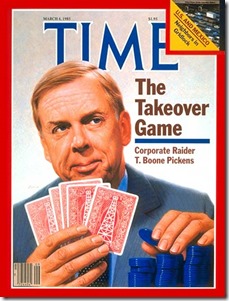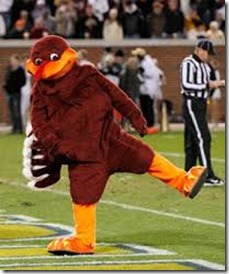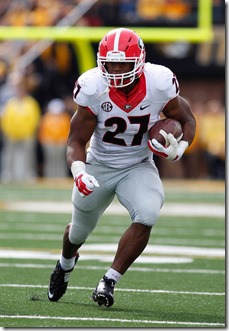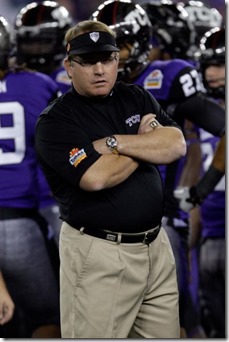For 2017, instead of previewing conferences division-by-division, I decided to preview the 64 Power Five teams individually, so I ranked them and counted down from the bottom.
I created a ranking system based heavily off of Bill Connelly’s S&P+ rankings: half of the ranking comes from the S&P rankings from the past five seasons among Power Five teams (1/3 of that number is 2016’s ranking; 1/3 is the average from 2014-2016, 1/3 is the average from 2012-2016); half comes from two component parts of his 2017 S&P+ projections, weighed evenly – recruiting impact and returning production – and ranked 1 through 64. There is no subjectivity involved in these rankings and they skew towards emphasizing where the teams were according the 2016 S&P+. I think it serves as a decent way to sequence these previews.
Previously: #64 Purdue, #63 Rutgers, #62 Kansas, #61 Illinois, #60 Boston College, #59 Virginia, #58 Vanderbilt, #57 Syracuse. #56 Maryland, #55 Arizona, #54 Wake Forest, #53 Duke, #52 Iowa State, #51 Texas Tech, #50 Missouri, #49 Oregon State. #48 Arizona State, #47 Cal, #46 Indiana, #45 Kentucky, #44 West Virginia, #43 South Carolina, #42 Washington State, #41 Northwestern. #40 Minnesota, #39 Iowa, #38 Colorado, #37 Kansas State, #36 Utah, #35 Georgia Tech, #34 Nebraska, #33 Michigan State. #32 North Carolina, #31 NC State, #30 UCLA, #29 Mississippi State, #28 Oregon, #27 Arkansas, #26 Pittsburgh, #25 Baylor.
(I didn’t include Notre Dame)
24. OKLAHOMA STATE![okst17 okst17]()
#4 Big 12
10-3 (7-2) in 2016
Mike Gundy’s been phenomenal at Oklahoma State, leading the Cowboys to a 104-50 record since taking over for the 2005 season. The former Cowboy QB has had five seasons with double digit wins as the head coach in Stillwater; in 2011, they finished with just one loss and were snubbed from the BCS Title Game in favor of giving Alabama a rematch against LSU. In three of the last four seasons, they’ve won ten games – ascending to at least the fringe of the Top 10 in each season before losing the finale to Oklahoma (they upset the Sooners in 2014, a down year at 7-6). Gundy’s shepherded the program for over a decade and has made good use of the T. Boone Pickens resource pool.
A definitive win over a legitimately good team in a bowl game will always lead to increased expectations for the next season, and with Oklahoma State’s 38-8 victory over Colorado in the Alamo Bowl to close out the 2016 campaign, the Cowboys are receiving plenty of hype as the start of the 2017 season approaches. 2016 was an odd year: they were robbed of a win against Central Michigan (the game should have ended before a late Hail Mary); they beat a better-than-expected Pitt team the next week in a shootout; they lost their first and last Big 12 games and won every game in between. Their hopes of a Big 12 title were still alive entering the regular season finale, but they lost to OU by three scores.
A bigger reason why Oklahoma State is getting the “darkhorse playoff contender” label: they return one of the best QB / RB / WR trios in the country fully intact. Mason Rudolph is now a senior and has had an excellent career thus far in Stillwater – last season, he threw for 4,091 yards at a 63% completion rate and had 28 touchdowns to just 4 interceptions. RB Justice Hill was an unexpected instant impact player (rushing for 1,142 yards) and if he makes a freshman-to-sophomore leap, he could be an elite back. James Washington could have jumped to the NFL, but the senior WR is back after gaining 1,380 yards on an absurd 19.4 yards per catch last season. Rudolph / Hill / Washington is about as good as it gets, and they’re the biggest reason for excitement in Stillwater. Washington isn’t the only quality WR, as Jalen McCleskey and Marcell Ateman are proven commodities. The OL is experienced as well.
The defense will determine whether Oklahoma State is a threat to make the playoff or not. With just five starters returning from a unit that was average at best last season, there’s not much to indicate improvement. The Cowboys lost both DTs, both CBs, and two starting LBs – so there are some potentially glaring holes. If impact players emerge from the ether and the defense is good enough, OSU will be able to rack up a ton of wins leading up to their November showdown with Oklahoma (at home this time) – but that’s a big if.
The Big 12 is often criticized for its lack of defense, and Oklahoma State is the leading candidate to fulfill that stereotype. They have what could be the most explosive offense in the country helmed by one of college football’s best QBs. That alone is enough to put them near the top of the Big 12; if the defense is good enough, they should be able to win it.
23. VIRGINIA TECH![vt17 vt17]()
#2 ACC Coastal, #5 ACC
10-4 (6-2) in 2016
It’s always difficult to replace a legendary coach, but Virginia Tech made a great hire in luring Justin Fuente away from Memphis when Frank Beamer retired following the 2015 season. Beamer’s teams had floundered late in his tenure (especially on the offensive side of the ball), but he’d built the program from nothing and maintained a mostly consistent level of success throughout his career. Fuente managed to convince Bud Foster, Beamer’s terrific longtime DC, to stay, even though he may have been passed over for the head coaching job. Tech had gone .500 in ACC play over Beamer’s last four seasons, so Fuente didn’t face outsized expectations right away in Blacksburg.
Still, he turned things around quickly – especially on offense – and the Hokies managed to win the ACC Coastal. Virginia Tech lost their first game against FBS competition in 2016 to Tennessee by three touchdowns at a neutral site and had a weird stretch mid-season when they trounced UNC, were upset at Syracuse, and destroyed Miami within a three-week span. They gave Clemson a good fight in the ACC Championship Game, eventually losing by a single touchdown, and beat Arkansas in the Belk Bowl to finish 10-4 in Fuente’s first season.
Fuente is an offensive whiz, as evidenced by what he did with future first-round pick QB Paxton Lynch at Memphis, and he’ll have to get by in 2017 without many of the major pieces from last season – most notably QB Jerod Evans, who accounted for 41 total touchdowns as a senior in 2016. Redshirt freshman QB Josh Jackson (son of former longtime Michigan RB coach and famous exaggerator Fred Jackson) won the starting job; he’ll have Travon McMillan – the starting RB in 2016 – back as well as Cam Phillips, one of VT’s two major targets in the passing game. The Hokies also lost two key OL from last year’s squad. Jackson will inevitably be a downgrade from Evans in the short term and the attrition across the board suggests that the unit as a whole will take a step back even as Fuente goes from year one to year two in his new system.
The defense should be excellent as usual though. Foster corrected course last season after a brief blip in 2015, and even though the Hokies are still too prone to giving up big plays, their stout run defense has them as one of the better overall groups in the ACC. The heart of their defense is extremely strong, with both LBs – Andrew Motuapuaka and Temaine Edmunds – as all-conference type players. The DL will be reloading, but there’s more recruiting hype for that group than any other position group on the team. The DBs should be improved, with four of the five starters from last season back, led by CB Greg Stroman.
The Hokies open the season with a neutral site matchup against old rival West Virginia in a game that’s sure to recalibrate expectations for both teams. While the Coastal is improved, the best three teams in the ACC reside in the other division, so even with uncertainty on offense, Virginia Tech will have a shot at making it two consecutive division titles. A November showdown at Miami could prove to be decisive in that regard.
[19-22 after the JUMP]
22. GEORGIA![uga17 uga17]()
#3 SEC East, #8 SEC
8-5 (4-4) in 2016
It’s still hard to believe that Georgia got rid of Mark Richt. He coached in Athens for 15 years, and while his tenure peaked in 2002 (with a 13-1 season) and he didn’t win the SEC in his last decade at UGA, his level of sustained success was impressive. They fired him after two consecutive 10-3 seasons (2014 was much better than 2015, even though they finished with the same record) and he took the Miami job; Richt – as one of the better coaches in all of college football –seems to have gotten off to a strong start in Coral Gables and Georgia needed to hire the right replacement in order to avoid having made a brutal, self-inflicted blow to the program.
They hired their top candidate, Georgia alum Kirby Smart, who had no head coaching experience prior to getting the job. He spent his career as the DC at plenty of big name schools: Florida State, LSU, UGA, and Smart was with Saban at Alabama for several years. His first season was a disappointment – they barely got past FCS Nicholls State in the second week of the season; lost four of their first six SEC games, including against Vanderbilt; they blew a late two-score lead at home against rival Georgia Tech in the season finale. The circumstances of Smart’s arrival meant that immediate success was to be expected, and the Bulldogs need to improve in his second season, lest the honeymoon period emphatically end.
Having elite skill position talent is a good place to start. Both of Georgia’s tremendous RBs decided to return for their senior seasons: Nick Chubb recovered from a knee injury to run for 1,130 yards and 8 touchdowns, and Sony Michel averaged more yards per carry as a change-of-pace back. Georgia may have the best RB tandem in the country. They also have Jacob Eason – a former top QB recruit who had an up-and-down freshman season (while showing tantalizing flashes) – and TE Isaac Nauta, another blue-chip sophomore who could break out as perhaps the best player at his position in the entire SEC. The offensive line is the weak link, as the Bulldogs lost three multi-year starters from their 2016 group.
An inexperienced defense took a step back from elite to merely good in Smart’s first season, but 10 starters return and the unit could start to resemble the much-feared Saban / Smart groups from Tuscaloosa. The Bulldogs only lose one of their top fifteen tacklers from last season. Juniors LB Roquan Smith and DT Trenton Thompson are the best of the bunch and the rest of the front seven as a whole is stocked with fellow veteran former blue-chippers. The secondary doesn’t have the same type of top-end talent as the DL and LBs, but returns all four starters from a solid position group last season.
Georgia looks fantastic on paper outside of the OL: they have a QB with incredible potential, a dependable running game, and a potentially ferocious defense. Few teams can match their combination of talent and experience across the board, and if everything clicks, the Bulldogs could be a New Year’s Six Bowl type team. Road trips to Notre Dame, Tennessee, and Auburn could be tricky – but ultimately the midseason matchup with Florida in Jacksonville will be their biggest game: UGA has lost to Florida three times in a row and the winner of that game will have the inside track to winning the SEC East. If Smart wins fewer than double digit games with this roster, Georgia’s decision to replace Richt with him will look all the more perplexing.
21. TCU![tcu17 tcu17]()
#3 Big 12
6-7 (4-5) in 2016
Gary Patterson has long been considered one of the best coaches in college football, and for good reason: TCU’s had an undefeated season and they’ve won the Rose Bowl. Getting the chance to jump to the Big 12 following the defection of several schools – Patterson took a few years to get acclimated to the increased quality of competition, but won a share of the league in 2014. That 2014 team only lost to Baylor and was passed over for the final playoff spot for Ohio State. Most of the nucleus from that squad returned for 2015, especially on offense, but injuries and late-season losses to the Oklahoma schools prevented them from winning a share of the conference again.
A 23-3 record over two seasons is about as good as it gets, particularly for a recently promoted member for a Power Five conference, so it came as a surprise when TCU slipped to 6-7 last season. In 2015, the defense faltered some with several new starters – the offense did the same in 2016, and the defense didn’t improve enough. A narrow early loss to Arkansas in 2OT was a bad omen, and blowout losses to Oklahoma State and Kansas State late in the year closed out what was surely a frustrating season in Fort Worth. TCU almost lost to Kansas in October, and their only win over a bowl team was a blowout victory of a mid-freefall Baylor squad.
Chances are that the Horned Frogs will rebound this season, as there’s much more experience across the board. All but one starter Is back from last season on offense: former Texas A&M QB Kenny Hill was inconsistent a year ago but still has plenty of upside; RB Kyle Hicks ran for 1,042 yards and 12 touchdowns in 2016; the entire WR corps is back after an injury-riddled season a year ago; the OL has all but one member of its 2016 two-deep back on the roster again. In 2014, TCU scored 46.5 points per game – 2015 was slightly lower (42.1) and 2016 was a big drop-off (31.0). A lot will hinge on Hill’s development; if he can improve from last season and play like he did as a freshman sensation back at A&M, the Frogs could have one of the most dangerous offenses in the league.
Patterson’s classic 4-2-5 defenses haven’t been quite as ferocious in recent years, though that could change with all but one starter returning in the back seven. The secondary was too prone to giving up big plays in 2016, so there will need to be improvement in that regard. SS Travin Howard was a first-team all-conference performer a year ago, and is the star of the group – though LB Ty Summers is also quite good. Those two each totaled over 120 tackles last season. Patterson’s track record is as strong as it gets, but after slippage in the past two seasons, it’s fair to wonder whether they’ll be able to bounce back in 2017 with a revamped DL.
TCU should improve on last season’s win total. The first half of the schedule is especially tough, so the stakes will be set early – road trips to Arkansas, Oklahoma State, and Kansas State will be difficult. If the offense clicks and the defense gets back to where it’s been historically under Patterson, the Frogs could challenge the Oklahoma schools for the Big 12 title.
20. TEXAS![tex17 tex17]()
#2 Big 12
5-7 (3-6) in 2016
Over the last seven seasons, Texas has been awfully mediocre – especially by their lofty standards. The program with perhaps more inherent advantages than any other has gone a combined 46-42 since appearing in the BCS championship game back in 2009. That period spanned the decay of the Mack Brown era – in which the foundations of the program were slowly decimated – and the three-year Charlie Strong tenure. Strong did well to change the culture that had stagnated in the twilight of Brown’s reign, but ultimately his results on the field were clearly not good enough for one of college football’s blue-blood programs. Strong had seven losses each season he was in Austin.
An upset win over Notre Dame to open the 2016 season led some to believe that Texas was back, but a road loss in Week 3 to a not-very-good Cal team and three losses in four games to start Big 12 play killed any momentum from that win over an extremely overrated ND team. Even though Texas had a 2,000-yard rusher in burly D’Onta Foreman, the offense struggled in the last few weeks of the season and a loss at Kansas, who had previously winless in conference play, in the second-to-last game of the season sealed Strong’s fate. A blowout defeat to TCU in the finale ensured that the Longhorns wouldn’t be going to a bowl game.
In steps Tom Herman, the hottest coaching prospect in the country. Herman is moving up from Houston – he quickly built the Coogs into a Group of Five powerhouse with excellent recruiting and his ability to develop potent spread offenses. Herman was previously the OC for Ohio State during their recent national championship season. He’ll be without Foreman, though there’s enough talent there to expect Herman to continue the offense’s upward trajectory over the last few years. He’ll be deciding between sophomore Shane Buechele and freshman Sam Ehlinger at QB; it’s likely that RB Chris Warren will step into the starting role. The Longhorns have one of the best offensive linemen in the country in LT Connor Williams and that group should be a strength. It’s a question of when – not if – Herman will have his spread offense up and running at full speed; there’s a good chance that there will be some growing pains in 2017.
Strong’s defenses weren’t as good as expected for his reputation as a defensive guru, but he left plenty for Herman’s DC, Todd Orlando, to work with on that side of the ball. The Longhorns return their top seven tacklers and ten starters overall. Former five-star LB Malik Jefferson is the star, though the DL is probably the best position group with Poona Ford and Chris Nelson back. The defense was young in 2016 and improved over the course of the season, and should be one of the best in the Big 12 as long as the transition from Strong to Orlando is smooth.
Herman was considered the best hire of the offseason, and he’s stepping into a much better situation than Strong found when he arrived before the 2014 season started. There’s little reason to doubt that Herman will have immense success at Texas in time; of course, the vagaries of college football can torpedo situations that look ideal on paper. The Longhorns will improve enough to reach a bowl in 2017, though contention for the Big 12 title may have to wait until 2018. Of course, with this combination of talent, experience, and coaching, it wouldn’t be too surprising to see a breakthrough in his first season.





